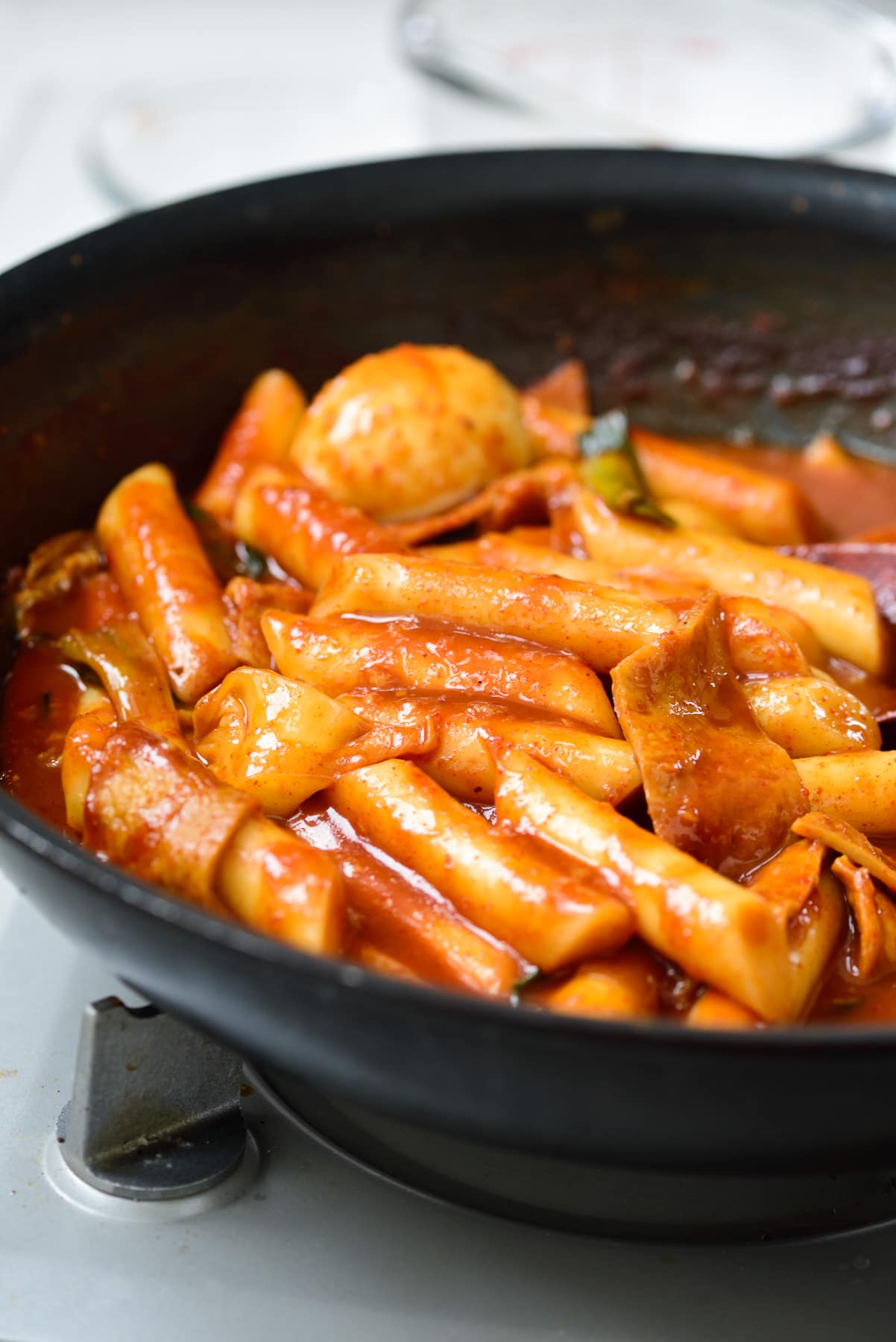Tteokbokki is a highly popular Korean street food and a delicious comfort food. You can make it at home with this easy tteokbokki recipe. The spicy, slightly sweet, and chewy rice cakes are simply addictive!
What is tteokbokki?
Literally translated as “stir-fried rice cake,” tteokbokki (떡볶이) is a beloved Korean rice cake dish with many variations and a rich history. It’s also spelled ddukbokki, ddeokbokki, dukbokki or topokki. This spicy rice cake dish is enormously popular as a street food and also often enjoyed at home.
Unlike gungjung tteokbokki, which has been around for hundreds of years, the red spicy tteokbokki has a relatively short history. It was developed in 1953, the year the Korean War ended, by a woman named Ma Bok-rim in the Sindang-dong neighborhood in Seoul. The chewy rice cake in a spicy gochujang sauce instantly became popular as an affordable comfort snack.
By the time I was growing up as a child, this spicy rice cake dish had become quite popular as a street food. The tteokbokki I grew up with was in its classic form without all the add-ins you see today. I have fond memories of eating it from street carts or market stalls as an after-school snack.
Ingredients for tteokbokki
Rice cakes
Tteokbokki is made with a type of rice cake called garaetteok (가래떡), a cylinder-shaped white rice cake made with short grain rice. The thick type is sliced into thin oval shapes for making tteokguk (rice cake soup), while thinner, shorter rice cakes are used for making tteokbokki, hence the name tteokbokki tteok (떡볶이떡). You can use either one for this recipe, but the thick type needs to be cut thinner and shorter for this recipe.
You can find these rice cakes freshly made, refrigerated, or frozen at Korean markets. They come in various shapes and sizes. Needless to say, locally made fresh ones are the best ones to use if available. Otherwise, use refrigerated (or frozen) ones.
Other additions
The classic and simple version I grew up eating had:
- eomuk (fish cake) – usually thin sheets of fish cake
- green cabbage, and
- scallions
- garlic
These are what I used in this tteokbokki recipe, and they add a lot to the flavor of the dish.
Tteokbokki has continued to evolve over time. Today, people add all sorts of other ingredients such as ramyun noodles, dumplings, boiled eggs, hot dogs, seafood and even cheese.
Tteokbokki sauce
Anchovy broth is typically used for a depth of flavor, but you can simply use water if you like. The main seasoning ingredients are:
Sometimes, gochugaru (고추가루, Korean red chili pepper flakes) is added for extra spiciness. It increases the heat level without altering the saltiness and sweetness. For the sweetness, you can simply use sugar or your other sugar substitutes. Koreans often also use syrup (e.g., oligo syrup) to add a sheen to the dish.
In this tteokbokki recipe, I’ve provided another combination of gochujang and gochugaru you can try if you like a clean tasting sauce with extra spiciness.
How to make tteokbokki
- Soak the rice cakes for about 20 minutes or longer unless you’re using freshly made soft rice cakes.
- Cut the fish cake, cabbage, and scallions into about 2-inch long pieces.
- In a large pan, stir in the sauce ingredients to the anchovy broth (or water). Bring it to a boil before adding the rice cakes.
- Add the rice cakes, and boil until the rice cakes become very soft and the sauce is thickened, about 8 – 10 minutes (can be longer), stirring occasionally.
- Add the vegetables and fish cakes. Continue to boil, stirring constantly, for an additional 4 – 6 minutes. Depending on rice cakes, you may need more time to reach a desired level of softness. Feel free to add more broth or water as necessary.
Vegan tteokbokki
Instead of anchovy broth, use water or vegetable broth for vegetarian or vegan tteokbokki. Simply omit the fish cake, or substitute it with fried tofu pockets called yubu. Some mushrooms will be nice as well.
Frequently Asked Questions
- Why do my rice cakes take long to soften even after being pre-soaked? Some refrigerated (and frozen) rice cakes are very dry and hard. Try soaking longer if yours are like that. Those can be soaked for hours to overnight.
- What other broth can I use if I don’t have anchovy broth? Tteokbokki is commonly made with water. You can also use any broth you want, such as vegetable broth or chicken broth.
- How do I make tteokbokki not as spicy? You can reduce the amount of gochujang and omit gochugaru entirely. If reducing gochujang, you will need more soy sauce because gochujang also adds saltiness. For a completely mild dish, try gungjung tteokbokki.
- How do I reheat leftover tteokbokki? Unfortunately, these rice cakes don’t reheat well in the microwave. They can get dry and hard. Your best option is to simmer the leftovers in a sauce pan, covered, with some water or broth over medium low heat. Stir once in a while.
Watch how to make it
More tteokbokki variations
Gungjung tteokbokki
Seafood cheese tteokbokki
Soupy tteokbokki – with ramyun
For more Korean cooking inspirations, follow along on YouTube, Pinterest, Twitter, Facebook, and Instagram.

Ingredients
- 1 pound tteokbokki tteok 떡볶이 떡 (about 24 3-inch long rice cake pieces) See Note 1
- 1-2 eomuk 어묵 (fish cake) sheets
- 4 ounces green cabbage (yangbaechu, 양배추)
- 1-2 or scallions
- 1 tablespoon minced garlic
Anchovy broth if using
- 8-10 medium to large dried anchovies (마른멸치), about 0.5 ounces (15 grams) Or simply use a broth packet.
- 1 piece dasima (dried kelp), about 3-inch square
- 1/4 medium onion, roughly sliced
Tteokbokki Sauce
- 3 cups anchovy broth or water (use 4 cups for more sauce)
- 3 tablespoons gochujang, 고추장 See Note 2
- 1-3 teaspoons gochugaru, 고추가루 See Note 3
- 1 tablespoon soy sauce
- 2 tablespoons sugar (use 1 tablespoon for less sweet tteokbokki)
- 1 tablespoon corn syrup (or oligo syrup) - use more sugar if not using
Optional
- 2 boiled eggs
Instructions
- Soak the rice cakes for about 20 minutes (can be longer for refrigerated rice cakes).
- Cut the fish cake, cabbage, and scallions into about 2-inch long pieces.
- To a large pan, add the dried anchovies, dried kelp, and onion along with 5 cups of water. Bring it to a boil over medium high heat, and continue to boil for 10 minutes. Reduce it close to medium if your heat is very high. Remove the anchovies, dasima and onion from the broth.
- Add the sauce ingredients to the pan, stirring to dissolve the red chili pepper paste (gochujang).
- Add the rice cakes. Boil until the rice cakes become very soft and the sauce is thickened, about 8 - 10 minutes. This can take longer, depending on your rice cakes. Stir frequently so the rice cakes don't stick to the bottom of the pan.
- Drop the vegetables, garlic, and fish cakes in. Continue to boil, stirring occasionally, for an additional 4 - 6 minutes. Depending on rice cakes, you may need more time to reach a desired level of softness. Add more broth or water as necessary. Drop in the scallions and boiled eggs with 2 to 3 minutes remaining. Taste the sauce, and adjust the seasoning if needed. Serve hot.
Notes
This is an update of the tteokbokki recipe that was originally posted in March 2012. I’ve updated it here with more information, new photos, and minor changes to the recipe.
































